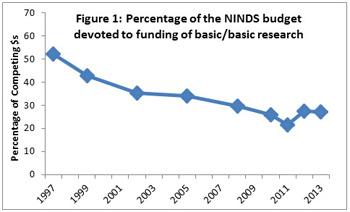Earlier this year, Dr. Landis and I wrote a blog post and accompanying editorial about the importance of maintaining a robust portfolio of basic neuroscience research. This week, NINDS released a funding opportunity announcement (FOA) designed as a call for applications for basic research that is not explicitly disease-related – research that addresses questions involving the development, structure and/or function of the normal nervous system.
Through this FOA, we hope to underscore our commitment to investigator-initiated basic neuroscience research. Our goal for the FOA is twofold: to stimulate more basic research applications that can be funded within our pay line, and to fund up to 12 additional applications each year with scores outside the pay line using a set-aside of up to $5 million per year for the duration of this FOA.
Reflecting the broad-based dedication to basic research across the NIH neuroscience community, NIMH, NIDA, and NIA have also committed funds and signed on to this announcement. Applications will be reviewed in the appropriate study sections within the NIH Center for Scientific Review (CSR).
Why the new FOA?
Our initial blog post on this topic presented an analysis of NINDS funding patterns and revealed a striking decline in our funding for basic research. This decline was especially pronounced for “basic/basic” research focused on understanding the normal nervous system, which decreased from 52% of our budget to 27% between 1997 and 2012. Further analysis comparing the number of applications between 2008 and 2011 revealed two important findings: 1) the rate at which basic/basic grant applications were funded was higher than the rates of other categories; and 2) there was an alarming decrease in the number of research applications submitted by PIs (-23%) to conduct basic/basic research. Taken together, the evidence that fewer PIs are seeking support for basic/basic research from NINDS is troubling.
We believe that one important reason for the fall-off in basic research applications is the perception that NINDS, and by extension the study sections that review our grants, favors projects with a disease-related focus. Again, I want to make clear that this is not the case. As we emphasized in our previous post, basic research fuels the entire research enterprise, and NINDS is committed to maintaining a robust portfolio of research into the fundamental nature of the brain and nervous system. These fundamental discoveries are critical to our ability to fulfill our public health mission, and lay the groundwork for all efforts to understand and treat disorders of the nervous system.

We continue to monitor our funding patterns closely – in FY 2013, 27% of our competing dollars went to basic/basic research (Figure 1), the same percentage we supported in FY 2012. This recent stability in funding level is a welcome change, but at least in part, the bend in this curve reflects programmatic efforts within the Institute rather than an increase in applications. We thus remain deeply concerned that researchers are not choosing to pursue important basic neuroscience questions and we hope that this funding opportunity stimulates a wave of applications investigating the underlying biology of the nervous system.
Our earlier post generated a great deal of helpful feedback: several people submitted thoughtful remarks to our blog’s comment section, others sent personal emails, and articles appeared in Science and Genetic Engineering and Biotechnology News. The general consensus of this feedback was that NINDS should take steps to increase the number of applications focused on basic neuroscience, as well as communicate our dedication to the funding of high quality basic science to the research community. I continue to welcome any suggestions about how to accomplish these goals.
While we pursue investigations into why basic science applications have decreased, we have already implemented several strategies to restore balance to our funding portfolio. For example, we have worked closely with the NIH CSR to address the perception that reviewers favor disease-focused research, including incorporating new language in reviewer guidelines that emphasizes the importance of every component of the research spectrum - basic, translational, and clinical.
As always, NINDS remains committed to supporting research across the spectrum: from basic and disease-related discovery research, to translational research to develop new therapeutics and diagnostics, and clinical research to understand and treat neurological disease. Our hope is that this new FOA will help ensure that basic neuroscience research continues to further our understanding of the underlying biology of the nervous system, thereby paving the way for clinical advances and improved neurological health.
